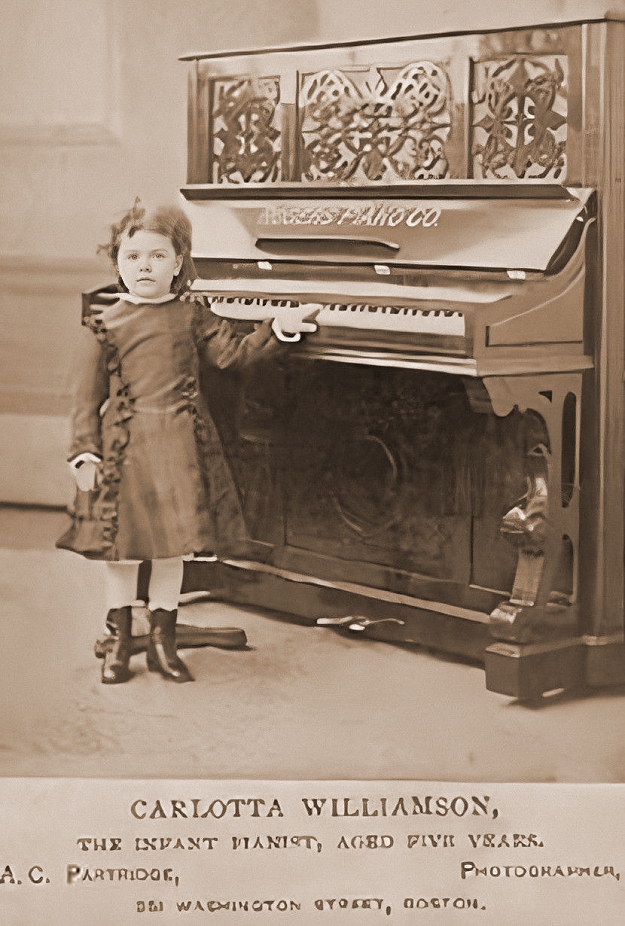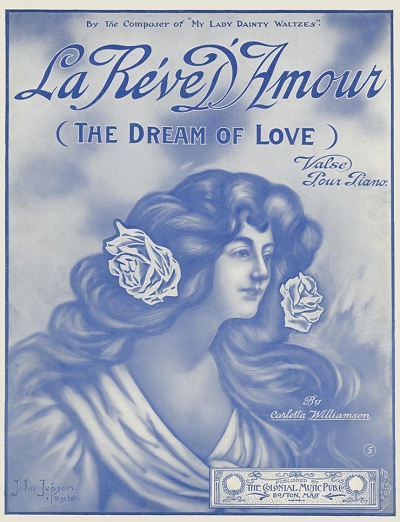Carlotta Williamson was one of two siblings born to Erastus Edward Williamson and Mary Ann (Rich) Carrigan (the Rich name may have been from a stepfather) in Hyde Park, Massachusetts, the other one being her older brother Edward Rich (6/17/1864), born in Fairmont, Massachusetts. She spent most of her life in the Boston, Massachusetts vicinity. Carlotta was evidently a child prodigy, as an advertising card from around 1874 showed her standing by a large upright, listed as "Carlotta Williamson, Infant Pianist, Aged 5 Years." There were also some notices in Boston papers of the mid 1870s noting the young performing prodigy in various area venues, often billed as "(the child pianist)." Mary sang with her daughter at some of these events.
in Hyde Park, Massachusetts, the other one being her older brother Edward Rich (6/17/1864), born in Fairmont, Massachusetts. She spent most of her life in the Boston, Massachusetts vicinity. Carlotta was evidently a child prodigy, as an advertising card from around 1874 showed her standing by a large upright, listed as "Carlotta Williamson, Infant Pianist, Aged 5 Years." There were also some notices in Boston papers of the mid 1870s noting the young performing prodigy in various area venues, often billed as "(the child pianist)." Mary sang with her daughter at some of these events.
 in Hyde Park, Massachusetts, the other one being her older brother Edward Rich (6/17/1864), born in Fairmont, Massachusetts. She spent most of her life in the Boston, Massachusetts vicinity. Carlotta was evidently a child prodigy, as an advertising card from around 1874 showed her standing by a large upright, listed as "Carlotta Williamson, Infant Pianist, Aged 5 Years." There were also some notices in Boston papers of the mid 1870s noting the young performing prodigy in various area venues, often billed as "(the child pianist)." Mary sang with her daughter at some of these events.
in Hyde Park, Massachusetts, the other one being her older brother Edward Rich (6/17/1864), born in Fairmont, Massachusetts. She spent most of her life in the Boston, Massachusetts vicinity. Carlotta was evidently a child prodigy, as an advertising card from around 1874 showed her standing by a large upright, listed as "Carlotta Williamson, Infant Pianist, Aged 5 Years." There were also some notices in Boston papers of the mid 1870s noting the young performing prodigy in various area venues, often billed as "(the child pianist)." Mary sang with her daughter at some of these events.Erastus left Mary and Carlotta in the late 1870s, taking Edward with him and leaving the two women destitute. By the time of the 1880 census he was living in Quincy, Massachusetts, in his second marriage with a women who had also left her previous husband. There are curiously two listings for Mary and Carlotta that year, the first on June 5 when they were residing with Mary's parents, the Riches, and the second on June 10 where they were living in a boarding house on Cambridge Street in Boston with Mary working as a dress maker. No definitive information was located on what type of income Carlotta had as a teen-aged pianist, but it was likely only a token amount that did not ease their poverty by all that much.
There were scant mentions of Carlotta in the Boston papers playing at one or another special event in the 1880s, a few even appearing after her first foray into marriage. Carlotta was married in Boston to Edward B. Wickwire on April 29, 1891. Their union lasted only four or so years, and even with a husband to help support her, there was an October 1895 notice of her divorce proceedings printed in the Boston Daily Globe about her having to continue to find work to make ends meet. Carlotta finally had to quit working owing to poor health, as she was very slight in stature. Due to no continuing support by Wickwire her divorce was readily granted.
By the mid-1890s Carlotta was lovingly remembered as the "former" child prodigy. Now single again she resumed her maiden name, and at the time of the 1900 enumeration she continued to reside with Mary in Boston. However, instead of performing music she was now working as a salesperson in a hat store while Mary was still making dresses. There were four other lodgers residing in their Clarendon Street unit.
The turn of the new century was around the time that Carlotta started to apply her musical gift to composition. In 1901 she had three of her first pieces published, the self-named Carlotta Waltzes, My Lady Dainty, and The Pickaninny: Cake Walk, plus a couple of songs with Boston lyricist William Henry Gardner. In an article in the May 30, 1903 edition of The Music Trade Review, it was stated that:
Women composers are still a rarity in this country, and few have made a success in the field as yet The West and the East seem to share the honors on popular compositions, and perhaps the best known woman composer in New England is Miss Carlotta Williamson, of Boston, who is connected with the music department of the great store of the Jordan-Marsh Company.
It was while working at the prestigious Jordan-Marsh department store in the 1900 time frame that Carlotta met her future husband.  George M. Blandford was also previously married, shown for the 1900 census with his wife Lillian Roulston, working as a buyer in a music store (very likely the aforementioned Jordan-Marsh), while he was working as a bookkeeper. It may have ironically been through his wife that George was introduced to Carlotta. Sadly, Lillian Blandford died in late 1900 just days after giving birth to their son.
George M. Blandford was also previously married, shown for the 1900 census with his wife Lillian Roulston, working as a buyer in a music store (very likely the aforementioned Jordan-Marsh), while he was working as a bookkeeper. It may have ironically been through his wife that George was introduced to Carlotta. Sadly, Lillian Blandford died in late 1900 just days after giving birth to their son.
 George M. Blandford was also previously married, shown for the 1900 census with his wife Lillian Roulston, working as a buyer in a music store (very likely the aforementioned Jordan-Marsh), while he was working as a bookkeeper. It may have ironically been through his wife that George was introduced to Carlotta. Sadly, Lillian Blandford died in late 1900 just days after giving birth to their son.
George M. Blandford was also previously married, shown for the 1900 census with his wife Lillian Roulston, working as a buyer in a music store (very likely the aforementioned Jordan-Marsh), while he was working as a bookkeeper. It may have ironically been through his wife that George was introduced to Carlotta. Sadly, Lillian Blandford died in late 1900 just days after giving birth to their son.Blandford, now a widower, soon arranged to have Williamson's pieces published under his own logo of G.M. Blandford, which would at some juncture morph into the Colonial Music Company by 1903. Carlotta and George were married in Boston on September 11, 1905. Over the next decade George would issue many different pieces from intermezzos and waltzes to mature rags out into the world, all published under Carlotta's maiden name, and with her husband supporting her throughout. One of Carlotta's last works, Wild Flower Rag, was her most exquisite and well developed piece, and is the one that is best known a century later.
For the 1910 census George was still listed as a bookkeeper, at that time in an electrical office, and Mary Williamson was residing with the Blandfords. Carlotta proclaimed herself to be a music composer. However, that was also pretty much at the end of her career. The couple did not have children so no surviving family was available to find out much about her later years. As of the 1920 enumeration George was listed as an accountant, but Carlotta had no career. The same is true for the 1930 census, followed by a similar listing in Boston city directories from 1933 forward. However, there were a couple of notices of her playing on the radio in the mid to late 1920s.
George died on July 1, 1936, and Carlotta was shown as a widow in the 1937 Boston city directory and the 1940 and 1950 enumerations, which listed no occupation for her. In the early 1940s she was involved with the G.O.P. Dorchester Women and provided musical programs for some of their meetings. Carlotta lived at the same address on Lyndhurst in the Dorchester neighborhood of Boston until 1948. Then she moved into a small apartment near Boston University for several years, and finally into an elder care facility in 1955. Little else is known beyond that except her death at age 88. However, we still have Carlotta's legacy of ragtime era music from Boston.
Thanks to Ragtime Women historian Nora Hulse, for providing a date of death and information on a couple of Williamson's compositions. The remaining information was researched by the author from numerous public records and assorted articles.

 Compositions
Compositions